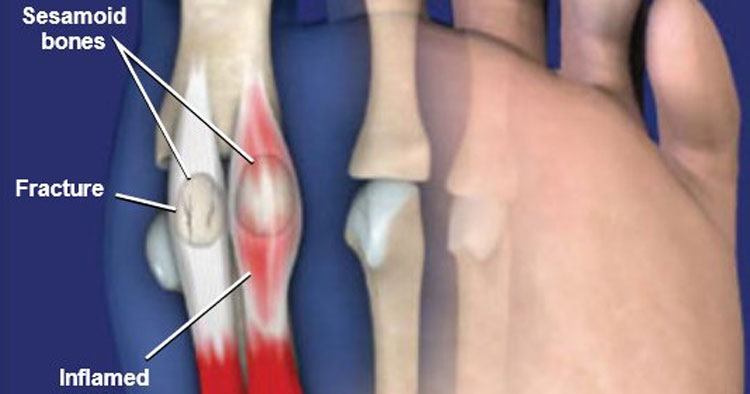Back and Joint Pain, Sports Injuries and Management
Diagnosis And Treatment Of Sesamoid Injury
Diagnosing Sesamoid Injury
Beyond taking a detailed history of the condition, when diagnosing sesamoid injury to the big toe physiotherapy assessment will include a physical examination looking for tenderness on palpation or manipulation of the sesamoid bones. As well as this, assessment will look to elicit pain with bending and straightening the great toe, where frequently bending the big toe up into extension (a movement of the toe puling it back toward the top of the foot) will frequently intensify the pain. Both gait and the wear pattern of the shoes are also worth examining, assessing gait and footwear give an idea regarding the loading stress and any loading changes potentially causing (or resulting) from sesamoid injury.
As well as a physical assessment by a physiotherapist or podiatrist the use of X-rays of the forefoot are commonly performed, including comparison X-rays of the other foot comparing bone structure. If the X-rays appear normal, but more information is required then more advanced imaging studies may be ordered including that of a bone scan, or MRI. If indicated your doctor my refer for some blood tests if they suspect the cause of the pain is related to gout, or inflammatory arthritis.
Treatment Of Big Toe Sesamoid Pain
Non-operative treatment of sesamoid injury is ideal, however, if conservative measures fail or your orthopaedic surgeon feels surgery is the most appropriate option then surgery will be carried out. Your foot and ankle surgeon will determine the type of procedure that is best suited to your individual needs. With regard to non-surgical treatment the exact nonoperative approach carried out will vary depending on the type and severity of sesamoid injury. In many circumstances it may take several months for the discomfort to subside before a gradual return to activity is possible. The first approach to treating sesamoid injury such as sesamoiditis is stopping the activity assessed to be causing the pain and avoiding activities that put your body weight on the balls of the feet. Other treatment approaches for sesamoid injury offered by your treating practitioner may include any of the following options:
- Immobilisation, carried out through placing the foot in a cast, orthopaedic boot, or a post op. shoe. This period of immobilisation may be recommended to be carried out with, or without crutches which depending on individual circumstances may be used to prevent placing any weight on the foot for a period of time.
- Taping or padding techniques, padding may be used in the shoe to cushion an area and offload the sesamoid. The toe may also be taped to relieve the area of tension and restrict motion, or taping the foot arches to contorl unwanted rolling seen to be contributing to stress on the big toe area.
- Prescription of semicustomised, or custom made orthotics from a podiatrist may be recommended for long-term treatment of sesamoiditis where the insole will be customised in a fashion to off load the sesamoid bones and improve overall biomechanics of the foot.
- Oral analgesics as well as anti-inflammatory medications (oral or topical) are often helpful in reducing associated pain and inflammation in the short term.
- Steroid injections are sometimes used to help manage pain and inflammation often where anti-inflammatory medications have been beneficial but failed to eliminate the discomfort, noting that the use of oral, topical or injectable medications without appropriate activity modification and footwear off loading approaches may have an underwhelming impact. Treatment of sesamoid pain of the great toe commonly requires a combination approach to achieve great results.
Disclaimer: Sydney Physio Clinic provides this information as an educational service and is not intended to serve as medical advice. Anyone seeking specific advice or assistance on Diagnosis And Treatment Of Sesamoid Injury should consult his or her physiotherapist, podiatrist or general practitioner.


